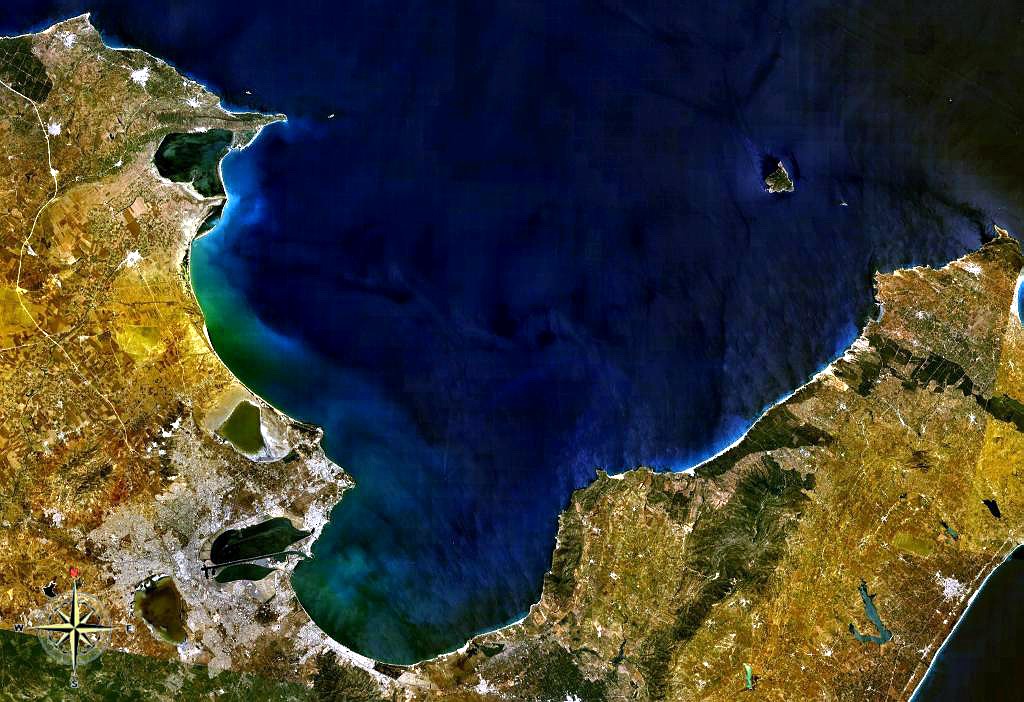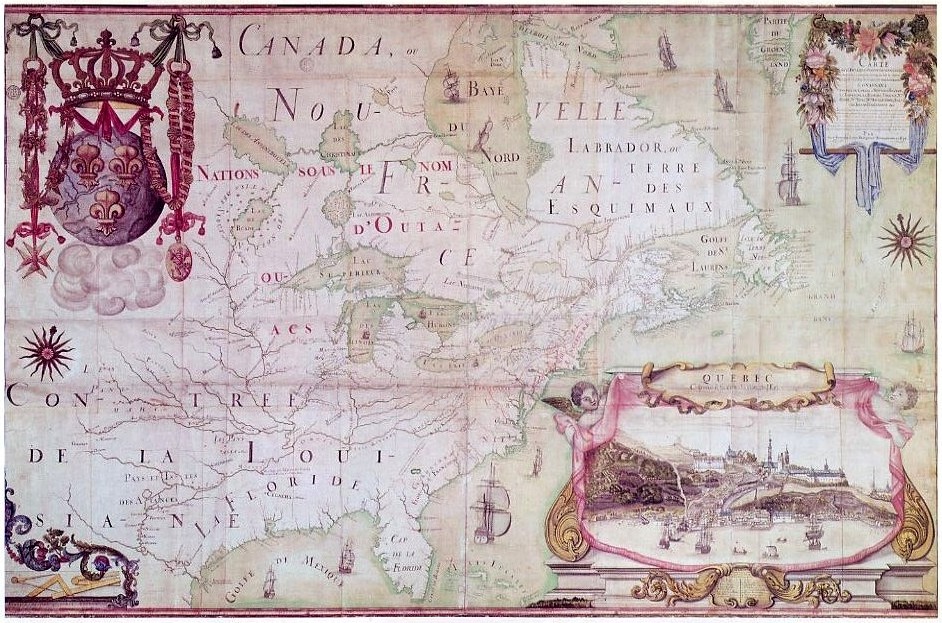|
Romaine River
The Romaine River (), known also as the Kanatuahkuiau, Uanaman Hipu, and Uepatauekat Shipu, is a river in eastern Canada. It flows from north to south, emptying into the Jacques Cartier Strait in the municipality of Havre-Saint-Pierre. The Romaine is a salmon river located in Minganie RCM, Côte-Nord, and Labrador regions within the provinces of Quebec and Newfoundland and Labrador. Geography The Romaine River is long. It is not to be confused with the Olomane River that is to the east and which had the same name for many years. The river is about long. It has its source on the boundary between the Atlantic and St. Lawrence watersheds, and flows first through a series of lakes, including the Long, Marc, Brûlé, Lavoie, Anderson, and Lozeau. This portion of the river to just past the confluence with Uauahkue Patauan Creek forms the boundary between Quebec and Labrador. Then it flows in a mostly southerly direction until a dozen miles from the coast where it takes a sharp ... [...More Info...] [...Related Items...] OR: [Wikipedia] [Google] [Baidu] |
Gulf Of St
A gulf is a large inlet from an ocean or their seas into a landmass, larger and typically (though not always) with a narrower opening than a bay (geography), bay. The term was used traditionally for large, highly indented navigable bodies of salt water that are enclosed by the coastline. Many gulfs are major shipping areas, such as the Persian Gulf, Gulf of Mexico, Gulf of Finland, and Gulf of Aden. See also * References External links * {{Geography-stub Gulfs, Bodies of water Coastal and oceanic landforms Coastal geography Oceanographical terminology ... [...More Info...] [...Related Items...] OR: [Wikipedia] [Google] [Baidu] |
Jean-Baptiste-Louis Franquelin
Jean-Baptiste-Louis Franquelin (; 1650-c.1712) was a French trader who was appointed in the early 1670s as the first Cartography, cartographer in ''Nouvelle France'' (Canada) by the colony's governor. He was appointed in 1688 as a royal Hydrography, hydrographer by Louis XIV. Franquelin was born in the commune of Pallauau-sur-Indre in central France. He migrated to New France in 1671 where he was soon appointed as the colony's cartographer. He documented a decade of Louis Jolliet and René-Robert Cavelier, Sieur de La Salle, René-Robert Cavelier de La Salle's explorations in North America. He also completed other projects for the Crown and served the king's military engineer. After returning to France in 1692, he never lived in Canada again. Biography Born at Palluau-sur-Indre, Saint-Michel de Villebernin, he grew up in the village in the small commune of Palluau-sur-Indre in central France. Having developed drawing and mapmaking skills, Franquelin migrated in 1671 from the Indr ... [...More Info...] [...Related Items...] OR: [Wikipedia] [Google] [Baidu] |
Ministry Of The Environment And The Fight Against Climate Change
The Ministry of Environment, Fight Against Climate Change, Wildlife and Parks (in French: Ministère de l’Environnement, de la Lutte contre les changements climatiques, de la Faune et des Parcs or MELCCFP) is responsible for environmental policy and land development in the province of Quebec. The ministry is also responsible for implementation of the provincial government's sustainable development plan, of which all provincial government agencies and organizations are party. The current minister is Benoit Charette. Québec Premier's Website Notes and references External links Official website [...More Info...] [...Related Items...] OR: [Wikipedia] [Google] [Baidu] |
Hydro-Québec
Hydro-Québec () is a Canadian Crown corporations of Canada#Quebec, Crown corporation public utility headquartered in Montreal, Quebec. It manages the electricity generation, generation, electric power transmission, transmission and electricity distribution, distribution of electricity in Quebec, as well as the export of power to portions of the Northeast United States. More than 40 percent of Canada’s water resources are in Quebec and Hydro-Québec is among the largest hydropower producer in the world. It was established as a Crown corporation by the government of Quebec in 1944 from the expropriation of private firms. This was followed by massive investment in hydro-electric projects like the James Bay Project. Today, with 63 hydroelectricity, hydroelectric power stations, the combined output capacity is 37,370 megawatts. Extra power is exported from the province and Hydro-Québec supplies 10 per cent of New England's power requirements. The company logo, a stylized "Q" fash ... [...More Info...] [...Related Items...] OR: [Wikipedia] [Google] [Baidu] |
Touladi River
The Touladi River flows in the administrative region of Bas-Saint-Laurent, south of the Gaspé Peninsula, in Quebec, Canada. This river runs through the regional county municipality (RCM) of: * Rimouski-Neigette Regional County Municipality: Rimouski Wildlife Reserve; * Témiscouata Regional County Municipality: municipalities of Biencourt, Esprit-Saint, Saint-Michel-du-Squatec and Sainte-Juste-du-Lac. The upper course of the river is in the Rimouski Wildlife Reserve, while the lower part (including the Little Touladi Lake and Touladi Lake that are located in the township of Robitaille) is administered by the Lake-Témiscouata National Park, which is the former territory of the Madawaska lordship. In the end of course, the Touladi River flows on the eastern shore of Lake Temiscouata, in the municipality of Saint-Juste-du-Lac or at the southern limit of Lake-Témiscouata National Park. The river side of the Touladi River is accessible by route 232 East. Geography The Tou ... [...More Info...] [...Related Items...] OR: [Wikipedia] [Google] [Baidu] |
Garneau River
The Garneau River is a tributary of the Turgeon River flowing in Canada in: *Cochrane District, Northeastern Ontario; *Nord-du-Québec, in Jamésie, in the municipality of Eeyou Istchee Baie-James (municipality) in the township of Récher. The surface of the river is usually frozen from early from November to mid-May, but safe circulation on the ice generally occurs from mid-November to the end of April. Geography The main watersheds adjacent to the Garneau River are: *North side: Kaokonimawaga Creek, Detour River, Turgeon River; *East side: Makwo Creek, Wijinawi Creek, Theo River, Wawagosic River; *South side: Adimoskadjiwi Creek, Turcotte River, Turgeon River; *West side: Turcotte River, Little Turcotte River (Ontario). The Garneau River originates at the mouth of a lake Garneau (length: ; elevation: ), in Cochrane District, in Ontario. The mouth of Lake Garneau is located at: * at west of the boundary between Ontario and Quebec; * at southeast of the mouth of the Ga ... [...More Info...] [...Related Items...] OR: [Wikipedia] [Google] [Baidu] |
Abbé Huard River
Abbé Huard River () is a river in the Côte-Nord region of the province of Quebec, Canada. It is a tributary of the Romaine River. The lower part of the river, where it meandered through sand and gravel deposits, has been flooded by the Romaine-2 reservoir. Location The Abbé-Huard River, a tributary of the Romaine River, originates in Abbé Huard Lake. The lake is in the unorganized territory of Lac-Jérôme, Quebec, Lac-Jérôme in the Minganie Regional County Municipality. It is a little more than north of the municipality of Baie-Johan-Beetz, Quebec, Baie-Johan-Beetz on the north shore of the Gulf of Saint Lawrence. The river is the second northeast branch of the Romaine River. The mouth of the river, where it meets the Romaine River, is also in Lac-Jérôme. Before the river was flooded, the Abbé-Huard entered the Romaine at PK 131. Name Abbé Huard Lake is named after the abbé Victor-Alphonse Huard (1853–1929), a naturalist and a professor at the Chicoutimi Seminary. ... [...More Info...] [...Related Items...] OR: [Wikipedia] [Google] [Baidu] |
Ekuanitshit, Quebec
Mingan, also known as Ekuanitshit in Innu-aimun, is an Innu First Nations reserve, at the mouth of the Mingan River, on Mingan Bay, on the North shore of the Gulf of St. Lawrence. It belongs to the Innu band of Ekuanitshit, geographically it is within Cote-Nord region, Minganie Regional County Municipality (administratively not part of it), Quebec, Canada. Geography The reserve is accessible via Quebec Route 138, east of the village of Longue-Pointe-de-Mingan and west of downtown Havre-Saint-Pierre. It is serviced by a health centre, community radio station, library, cultural centre, community store, municipal water and sewer system, fire station, and an aboriginal police force. The name Mingan, already appearing as ''mican'' on a map of 1631, is generally considered to originate from the Innu word ''maikan'', meaning "timber wolf". But there is no certainty over this interpretation. It has also been proposed that it may have come from the Basque word ''mingain'' meaning " ... [...More Info...] [...Related Items...] OR: [Wikipedia] [Google] [Baidu] |
Titanium
Titanium is a chemical element; it has symbol Ti and atomic number 22. Found in nature only as an oxide, it can be reduced to produce a lustrous transition metal with a silver color, low density, and high strength, resistant to corrosion in sea water, aqua regia, and chlorine. Titanium was discovered in Cornwall, Great Britain, by William Gregor in 1791 and was named by Martin Heinrich Klaproth after the Titans of Greek mythology. The element occurs within a number of minerals, principally rutile and ilmenite, which are widely distributed in the Earth's crust and lithosphere; it is found in almost all living things, as well as bodies of water, rocks, and soils. The metal is extracted from its principal mineral ores by the Kroll and Hunter processes. The most common compound, titanium dioxide (TiO2), is a popular photocatalyst and is used in the manufacture of white pigments. Other compounds include titanium tetrachloride (TiCl4), a component of smoke screens and cata ... [...More Info...] [...Related Items...] OR: [Wikipedia] [Google] [Baidu] |
Iron
Iron is a chemical element; it has symbol Fe () and atomic number 26. It is a metal that belongs to the first transition series and group 8 of the periodic table. It is, by mass, the most common element on Earth, forming much of Earth's outer and inner core. It is the fourth most abundant element in the Earth's crust, being mainly deposited by meteorites in its metallic state. Extracting usable metal from iron ores requires kilns or furnaces capable of reaching , about 500 °C (900 °F) higher than that required to smelt copper. Humans started to master that process in Eurasia during the 2nd millennium BC and the use of iron tools and weapons began to displace copper alloys – in some regions, only around 1200 BC. That event is considered the transition from the Bronze Age to the Iron Age. In the modern world, iron alloys, such as steel, stainless steel, cast iron and special steels, are by far the most common industrial metals, due to their mechan ... [...More Info...] [...Related Items...] OR: [Wikipedia] [Google] [Baidu] |




